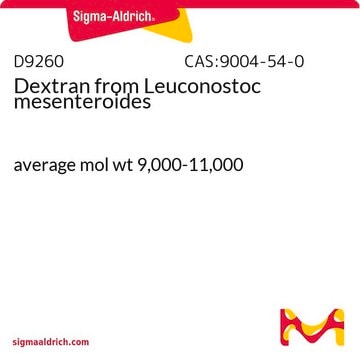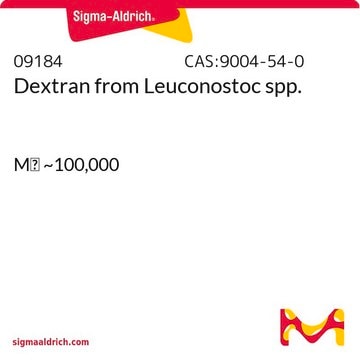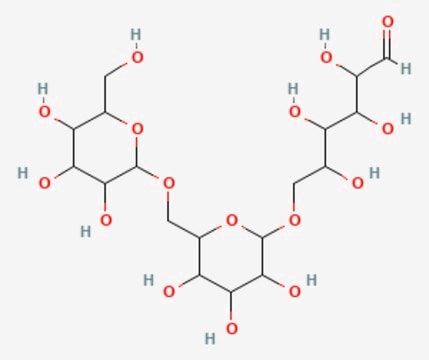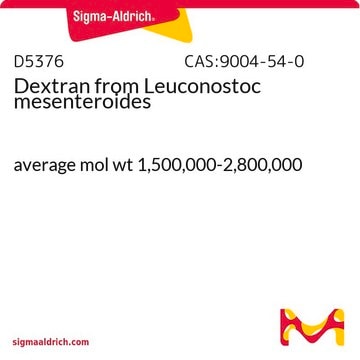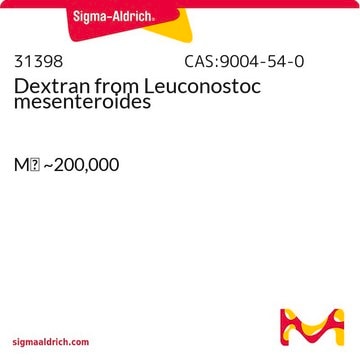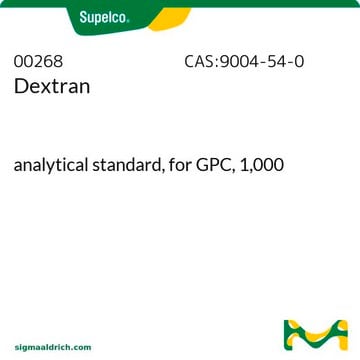31389
Dextran from Leuconostoc spp.
Mr ~40,000
Synonym(s):
DEXTRAN 40
About This Item
Recommended Products
biological source
(Leuconostoc spp)
form
powder
mol wt
Mr ~40,000
technique(s)
cryopreservation: suitable
gel permeation chromatography (GPC): suitable
loss
≤7% loss on drying
color
white
mp
483 °C ((901 °F ))
solubility
water: 1.5, clear, colorless
absorption
≤0.05 at 375 nm in H2O at 10%
suitability
suitable for additive or modifier in the separation of proteins or peptides
application(s)
advanced drug delivery
agriculture
sample preparation
storage temp.
room temp
InChI
1S/C18H32O16/c19-1-5(21)9(23)10(24)6(22)3-31-17-16(30)14(28)12(26)8(34-17)4-32-18-15(29)13(27)11(25)7(2-20)33-18/h1,5-18,20-30H,2-4H2
InChI key
FZWBNHMXJMCXLU-UHFFFAOYSA-N
Looking for similar products? Visit Product Comparison Guide
General description
application
- to mix with embryo suspension in seawater to prepare the sample for cryo-imaging
- to immerse the tails of zebrafish larvae for cryoimmobilization
- in the synthesis of vinyl sulfone modified dextran (DX-VS)
- in the synthesis of methacrylate functionalized dextran via ester linkage (DX-O-MeA)
- as a supplement in NCTC-135 tissue culture medium to prepare the perfusion medium
Dextran 40 is used in the development of new improved preservation solutions for organ transplantation. Dextran 40 may be used to determine cell tightness and flux parameters across cell layers. Dextran 40 is used as a colloidal plasma volume extender.
Biochem/physiol Actions
-Cryoprotection: Dextran acts as a cryoprotectant by forming a protective barrier around cells and tissues during freezing. This barrier inhibits the formation of ice crystals, which can damage cell membranes and structures.
-Viscosity Control: Dextran can alter the viscosity of solutions by increasing the molecular weight of the solution. This change in viscosity affects the flow properties of the solution, making it useful for controlling the thickness of solutions in various processes.
-Drug Delivery: Modified dextran serves as a carrier for controlled drug delivery. Dextran can encapsulate drugs and release them gradually, enhancing drug solubility and controlling the release profiles to improve therapeutic outcomes.
-Gel Electrophoresis: Dextran increases the density of sample loading solutions in gel electrophoresis. This increased density helps samples sink into the gel matrix, allowing for more precise separation of molecules based on size and charge during electrophoresis.
-Enzyme Stabilization: Dextran stabilizes enzymes by providing a protective environment. It forms a stable matrix around enzymes, enhancing their activity and extending their lifespan in various biochemical reactions. This protection prevents enzyme denaturation and inactivation, allowing enzymes to function more effectively.
Features and Benefits
- Dextran with an average molecular weight of 40,000
- Freely soluble in Water, DMSO, formamide, ethylene glycol, and glycerol
- Versatile and adaptable for various laboratory and research applications
Other Notes
comparable product
Storage Class
11 - Combustible Solids
wgk_germany
WGK 2
ppe
Eyeshields, Gloves, type N95 (US)
Certificates of Analysis (COA)
Search for Certificates of Analysis (COA) by entering the products Lot/Batch Number. Lot and Batch Numbers can be found on a product’s label following the words ‘Lot’ or ‘Batch’.
Already Own This Product?
Find documentation for the products that you have recently purchased in the Document Library.
Customers Also Viewed
Related Content
Dextrans are polysaccharides with molecular weights ≥1,000 Dalton, featuring a linear backbone of α-linked d-glucopyranosyl repeating units.
Our team of scientists has experience in all areas of research including Life Science, Material Science, Chemical Synthesis, Chromatography, Analytical and many others.
Contact Technical Service

